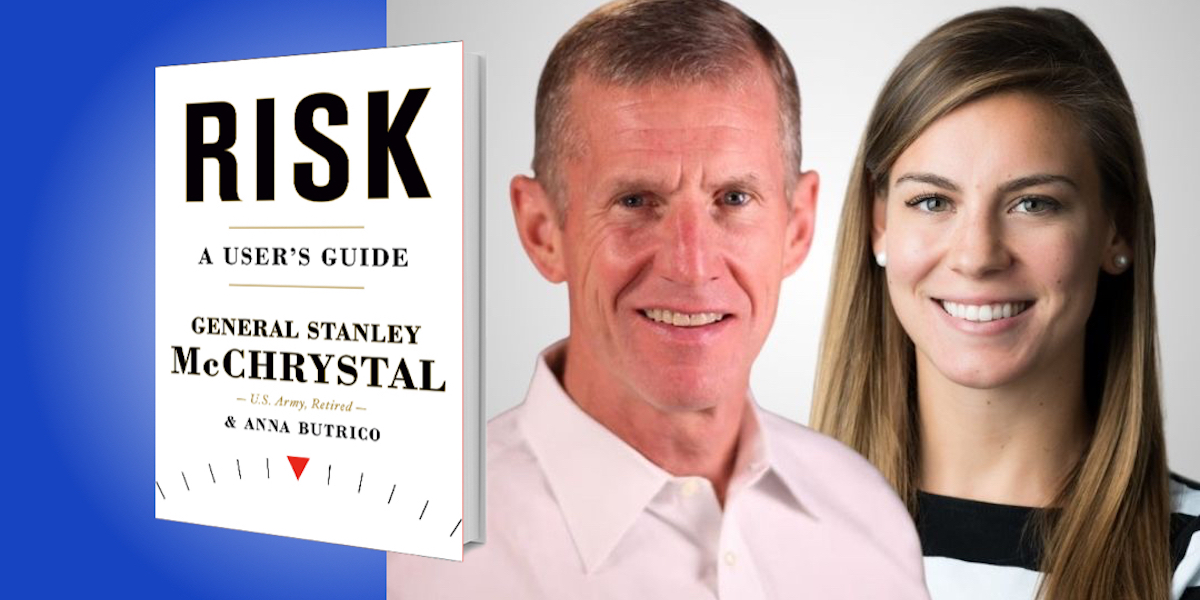Stanley McChrystal retired in July 2010 as a four-star general in the U.S. Army. The author of My Share of the Task, Team of Teams, and Leaders, he is currently a senior fellow at Yale University’s Jackson Institute for Global Affairs and the cofounder of McChrystal Group, a leadership consulting firm. Anna Butrico graduated from Vanderbilt University with a degree in English after spending time at St. Anne’s College, University of Oxford. She joined McChrystal Group in 2018, where she has advised Fortune 100 companies and partnered with General McChrystal as his speechwriter.
Below, Stanley and Anna share 5 key insights from their new book, Risk: A User’s Guide. Listen to the audio version—read by Stanley himself—in the Next Big Idea App.
1. Look inward: The greatest risk to us is us.
In December 2019, the world was stunned, and then painfully impacted, by the emergence of a novel coronavirus that came to be known as COVID-19. The comforting narrative claiming the pandemic was impossible to anticipate provided an excuse for governments and leaders, whose responses were painfully ineffective—but these claims were inaccurate. COVID-19 was simply the latest in a series of public health threats that, while impossible to predict with precision, are inevitable. In fact, much of COVID’s death toll was as avoidable as it was tragic.
It’s an oft-told story: We habitually fixate on threats we can neither predict nor prevent. At the same time, we neglect developing the very capabilities within ourselves that enable us to detect, assess, and respond to threats—and then learn from the experience. We have a tendency to expend all our efforts focusing on what we can’t control, and neglect those we have the agency to correct. In short, we are our own greatest risk.
“We have a tendency to expend all our efforts focusing on what we can’t control, and neglect those we have the agency to correct.”
2. It’s up to us: We have a risk immune system.
Humans are blessed with an extraordinary immune system that defends our health, yet we often take this life-saving marvel for granted. On a daily basis, our body faces about 10,000 potential threats (germs and pathogens) that could sicken or kill us. Most of the time, our immune system protects us, but when our immune systems weaken or fail, we are reminded of their importance.
As individuals, but most notably as organizations, we have a similar system to deal with the broad range of risks we face: We call it the “risk immune system.” Comprised of ten risk control factors—communication, action, timing, diversity, bias, technology, narrative, structure, adaptability, and of course, leadership—our risk immune systems provide us with the ability to detect, assess, respond, and learn about the threats that surround us. But like our health, we can’t take our risk immune systems for granted. Each factor, and the system as a whole, needs to be continuously developed and sustained so that vulnerabilities we create or allow aren’t, in fact, the greatest risk we face.
3. Be holistic: It’s the system—make it work.
An effective defense comes from an integrated system, not a collection of disconnected entities. Similarly, we need to strengthen our risk immune systems as systems—and then make them function. Orchestrating efforts across an organization, to ensure that factors as seemingly different as diversity and timing function in concert, requires that leaders be intentional and consistent. Leaders must connect the dots for team members whose role and focus preclude them from maintaining the broad view that C-suite executives take for granted.
“Like an internal combustion engine, risk immune systems work best when they work often.”
Our environment demands that we have the discipline to make the system work at all times, so these capabilities aren’t something we hope to pull out of storage in a moment of crisis. Like an internal combustion engine, risk immune systems work best when they work often.
4. Balance: The muscles you exercise will be strong, while those you ignore will become vulnerabilities.
Most athletes have a tendency to do the exercises they like more than those they really need. The same is true in organizations. Organizations that enjoy a world-class narrative or superb leadership have often enjoyed enough success for overconfidence, and even hubris, to creep in; they fail to consider how they can adapt and improve as conditions change. So don’t forget or neglect your skillset, but understand where you are weak and what your blind spots are, and course-correct accordingly.
5. Expend the effort: It’s our responsibility to take action.
A human whose body remains consistently healthy and athletically impressive with no apparent effort is irksome, not to mention very rare. This doesn’t happen much, if at all. The same applies to an organization’s ability to deal with risk: Seldom are teams perfectly poised to respond to every hazard that approaches. To build the blocks of resilience, teams must focus on factors like leadership, communication, action, timing, and diversity, constantly assessing and exercising them to be best positioned to respond. Executing the necessary tasks to strengthen our risk immune systems isn’t particularly complex; they can feel mundane, but they work. And this isn’t a one-time or occasional “nice-to-do” effort—it is essential for the ongoing health and survival of the team.
To listen to the audio version read by Stanley McChrystal, download the Next Big Idea App today:































